Developing Individuals, Teams and Organisations Assignment
VerifiedAdded on 2022/12/23
|11
|3253
|74
Report
AI Summary
This report delves into the core concepts of team management and high-performance working (HPW), exploring their benefits for organizations. It examines how HPW practices, such as training and development, mentoring, and performance management, can increase employee engagement, commitment, and ultimately, competitive advantage. The report further evaluates two performance management approaches, including collaborative working, highlighting their effectiveness in fostering a high-performance culture. Through detailed analysis and examples, the report provides a comprehensive understanding of strategies to enhance individual, team, and organizational performance, offering valuable insights for students and professionals seeking to improve workplace dynamics and achieve organizational success. The report also discusses the importance of recognizing and rewarding employee performance to boost morale and increase productivity.
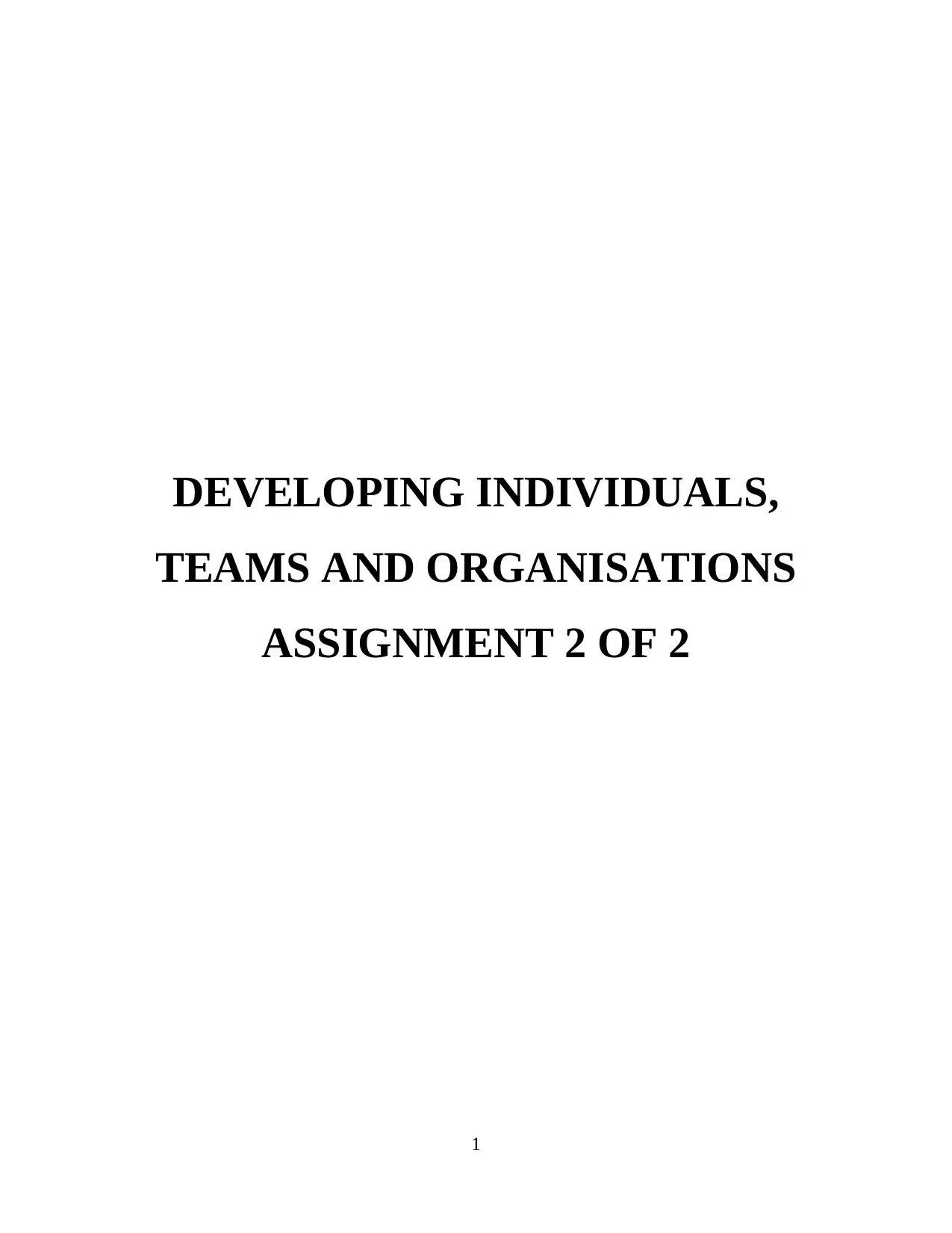
DEVELOPING INDIVIDUALS,
TEAMS AND ORGANISATIONS
ASSIGNMENT 2 OF 2
1
TEAMS AND ORGANISATIONS
ASSIGNMENT 2 OF 2
1
Paraphrase This Document
Need a fresh take? Get an instant paraphrase of this document with our AI Paraphraser
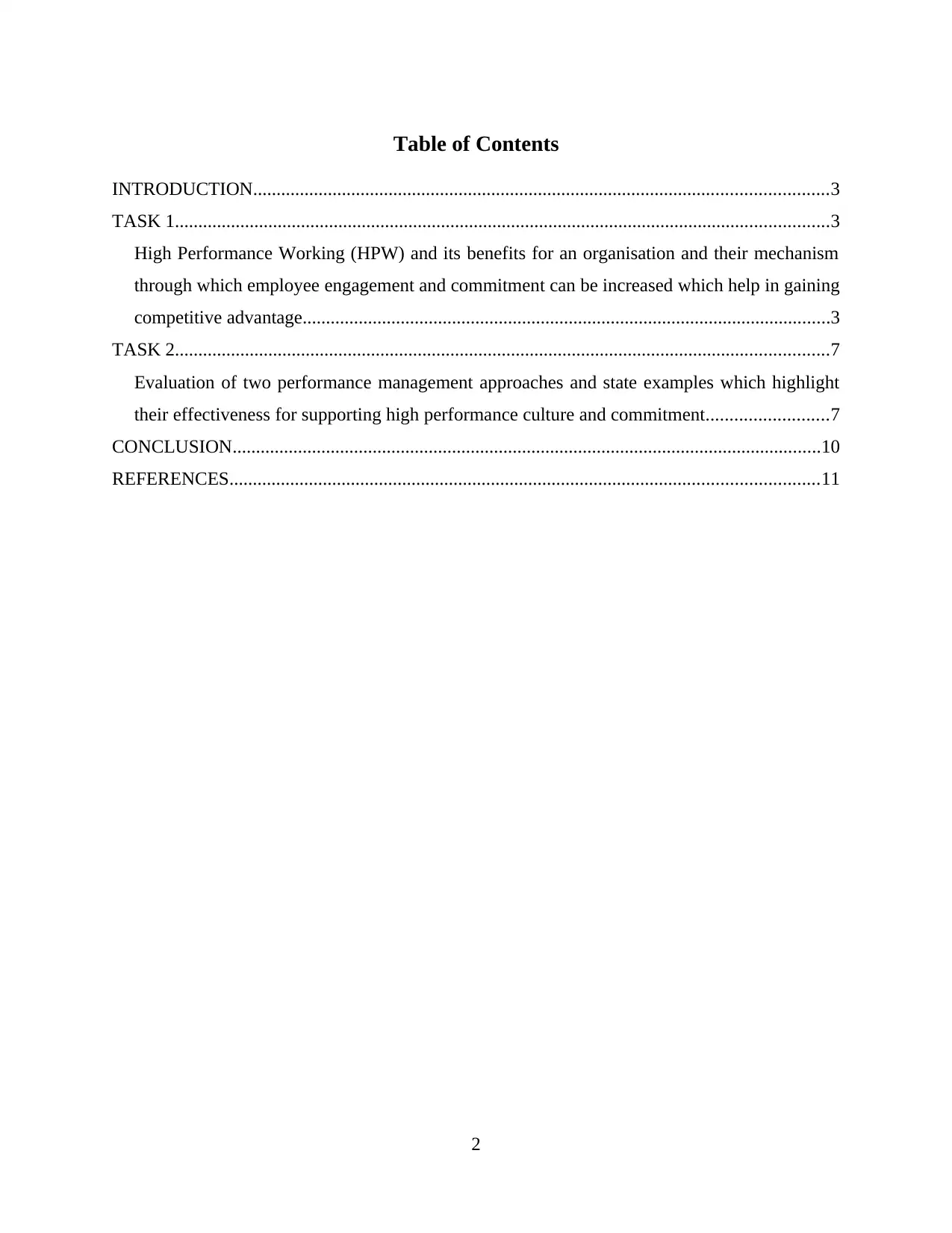
Table of Contents
INTRODUCTION...........................................................................................................................3
TASK 1............................................................................................................................................3
High Performance Working (HPW) and its benefits for an organisation and their mechanism
through which employee engagement and commitment can be increased which help in gaining
competitive advantage.................................................................................................................3
TASK 2............................................................................................................................................7
Evaluation of two performance management approaches and state examples which highlight
their effectiveness for supporting high performance culture and commitment..........................7
CONCLUSION..............................................................................................................................10
REFERENCES..............................................................................................................................11
2
INTRODUCTION...........................................................................................................................3
TASK 1............................................................................................................................................3
High Performance Working (HPW) and its benefits for an organisation and their mechanism
through which employee engagement and commitment can be increased which help in gaining
competitive advantage.................................................................................................................3
TASK 2............................................................................................................................................7
Evaluation of two performance management approaches and state examples which highlight
their effectiveness for supporting high performance culture and commitment..........................7
CONCLUSION..............................................................................................................................10
REFERENCES..............................................................................................................................11
2
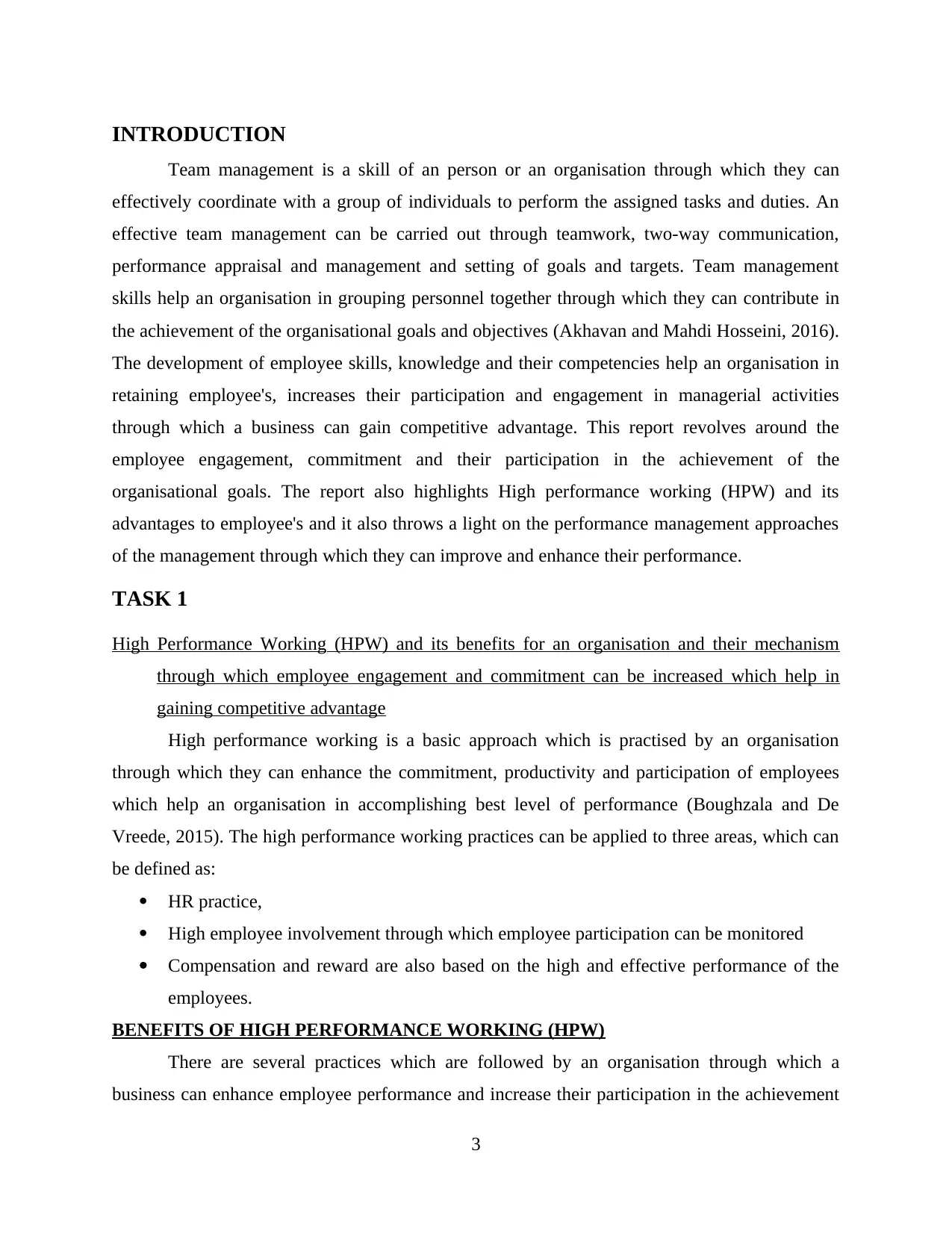
INTRODUCTION
Team management is a skill of an person or an organisation through which they can
effectively coordinate with a group of individuals to perform the assigned tasks and duties. An
effective team management can be carried out through teamwork, two-way communication,
performance appraisal and management and setting of goals and targets. Team management
skills help an organisation in grouping personnel together through which they can contribute in
the achievement of the organisational goals and objectives (Akhavan and Mahdi Hosseini, 2016).
The development of employee skills, knowledge and their competencies help an organisation in
retaining employee's, increases their participation and engagement in managerial activities
through which a business can gain competitive advantage. This report revolves around the
employee engagement, commitment and their participation in the achievement of the
organisational goals. The report also highlights High performance working (HPW) and its
advantages to employee's and it also throws a light on the performance management approaches
of the management through which they can improve and enhance their performance.
TASK 1
High Performance Working (HPW) and its benefits for an organisation and their mechanism
through which employee engagement and commitment can be increased which help in
gaining competitive advantage
High performance working is a basic approach which is practised by an organisation
through which they can enhance the commitment, productivity and participation of employees
which help an organisation in accomplishing best level of performance (Boughzala and De
Vreede, 2015). The high performance working practices can be applied to three areas, which can
be defined as:
HR practice,
High employee involvement through which employee participation can be monitored
Compensation and reward are also based on the high and effective performance of the
employees.
BENEFITS OF HIGH PERFORMANCE WORKING (HPW)
There are several practices which are followed by an organisation through which a
business can enhance employee performance and increase their participation in the achievement
3
Team management is a skill of an person or an organisation through which they can
effectively coordinate with a group of individuals to perform the assigned tasks and duties. An
effective team management can be carried out through teamwork, two-way communication,
performance appraisal and management and setting of goals and targets. Team management
skills help an organisation in grouping personnel together through which they can contribute in
the achievement of the organisational goals and objectives (Akhavan and Mahdi Hosseini, 2016).
The development of employee skills, knowledge and their competencies help an organisation in
retaining employee's, increases their participation and engagement in managerial activities
through which a business can gain competitive advantage. This report revolves around the
employee engagement, commitment and their participation in the achievement of the
organisational goals. The report also highlights High performance working (HPW) and its
advantages to employee's and it also throws a light on the performance management approaches
of the management through which they can improve and enhance their performance.
TASK 1
High Performance Working (HPW) and its benefits for an organisation and their mechanism
through which employee engagement and commitment can be increased which help in
gaining competitive advantage
High performance working is a basic approach which is practised by an organisation
through which they can enhance the commitment, productivity and participation of employees
which help an organisation in accomplishing best level of performance (Boughzala and De
Vreede, 2015). The high performance working practices can be applied to three areas, which can
be defined as:
HR practice,
High employee involvement through which employee participation can be monitored
Compensation and reward are also based on the high and effective performance of the
employees.
BENEFITS OF HIGH PERFORMANCE WORKING (HPW)
There are several practices which are followed by an organisation through which a
business can enhance employee performance and increase their participation in the achievement
3
⊘ This is a preview!⊘
Do you want full access?
Subscribe today to unlock all pages.

Trusted by 1+ million students worldwide
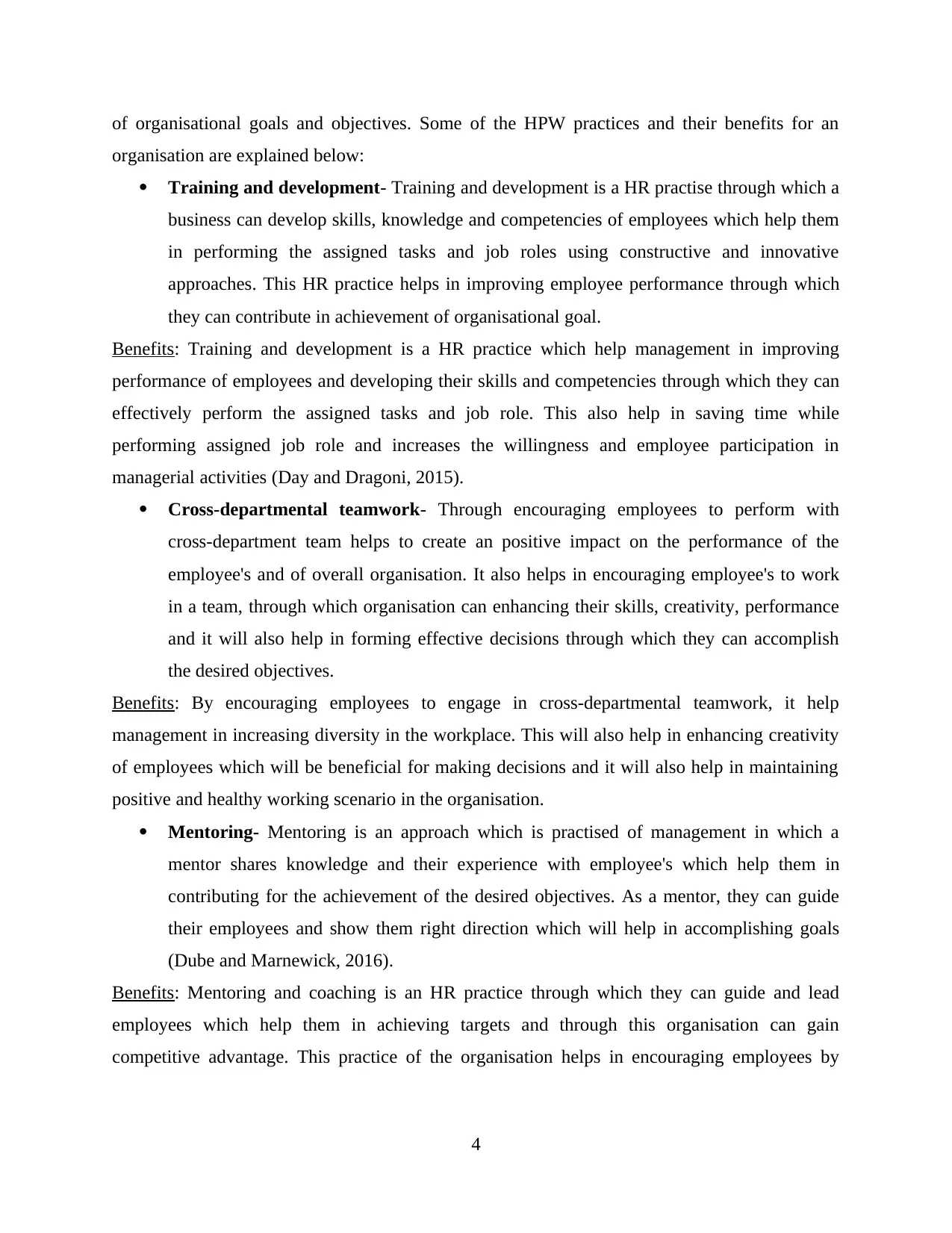
of organisational goals and objectives. Some of the HPW practices and their benefits for an
organisation are explained below:
Training and development- Training and development is a HR practise through which a
business can develop skills, knowledge and competencies of employees which help them
in performing the assigned tasks and job roles using constructive and innovative
approaches. This HR practice helps in improving employee performance through which
they can contribute in achievement of organisational goal.
Benefits: Training and development is a HR practice which help management in improving
performance of employees and developing their skills and competencies through which they can
effectively perform the assigned tasks and job role. This also help in saving time while
performing assigned job role and increases the willingness and employee participation in
managerial activities (Day and Dragoni, 2015).
Cross-departmental teamwork- Through encouraging employees to perform with
cross-department team helps to create an positive impact on the performance of the
employee's and of overall organisation. It also helps in encouraging employee's to work
in a team, through which organisation can enhancing their skills, creativity, performance
and it will also help in forming effective decisions through which they can accomplish
the desired objectives.
Benefits: By encouraging employees to engage in cross-departmental teamwork, it help
management in increasing diversity in the workplace. This will also help in enhancing creativity
of employees which will be beneficial for making decisions and it will also help in maintaining
positive and healthy working scenario in the organisation.
Mentoring- Mentoring is an approach which is practised of management in which a
mentor shares knowledge and their experience with employee's which help them in
contributing for the achievement of the desired objectives. As a mentor, they can guide
their employees and show them right direction which will help in accomplishing goals
(Dube and Marnewick, 2016).
Benefits: Mentoring and coaching is an HR practice through which they can guide and lead
employees which help them in achieving targets and through this organisation can gain
competitive advantage. This practice of the organisation helps in encouraging employees by
4
organisation are explained below:
Training and development- Training and development is a HR practise through which a
business can develop skills, knowledge and competencies of employees which help them
in performing the assigned tasks and job roles using constructive and innovative
approaches. This HR practice helps in improving employee performance through which
they can contribute in achievement of organisational goal.
Benefits: Training and development is a HR practice which help management in improving
performance of employees and developing their skills and competencies through which they can
effectively perform the assigned tasks and job role. This also help in saving time while
performing assigned job role and increases the willingness and employee participation in
managerial activities (Day and Dragoni, 2015).
Cross-departmental teamwork- Through encouraging employees to perform with
cross-department team helps to create an positive impact on the performance of the
employee's and of overall organisation. It also helps in encouraging employee's to work
in a team, through which organisation can enhancing their skills, creativity, performance
and it will also help in forming effective decisions through which they can accomplish
the desired objectives.
Benefits: By encouraging employees to engage in cross-departmental teamwork, it help
management in increasing diversity in the workplace. This will also help in enhancing creativity
of employees which will be beneficial for making decisions and it will also help in maintaining
positive and healthy working scenario in the organisation.
Mentoring- Mentoring is an approach which is practised of management in which a
mentor shares knowledge and their experience with employee's which help them in
contributing for the achievement of the desired objectives. As a mentor, they can guide
their employees and show them right direction which will help in accomplishing goals
(Dube and Marnewick, 2016).
Benefits: Mentoring and coaching is an HR practice through which they can guide and lead
employees which help them in achieving targets and through this organisation can gain
competitive advantage. This practice of the organisation helps in encouraging employees by
4
Paraphrase This Document
Need a fresh take? Get an instant paraphrase of this document with our AI Paraphraser
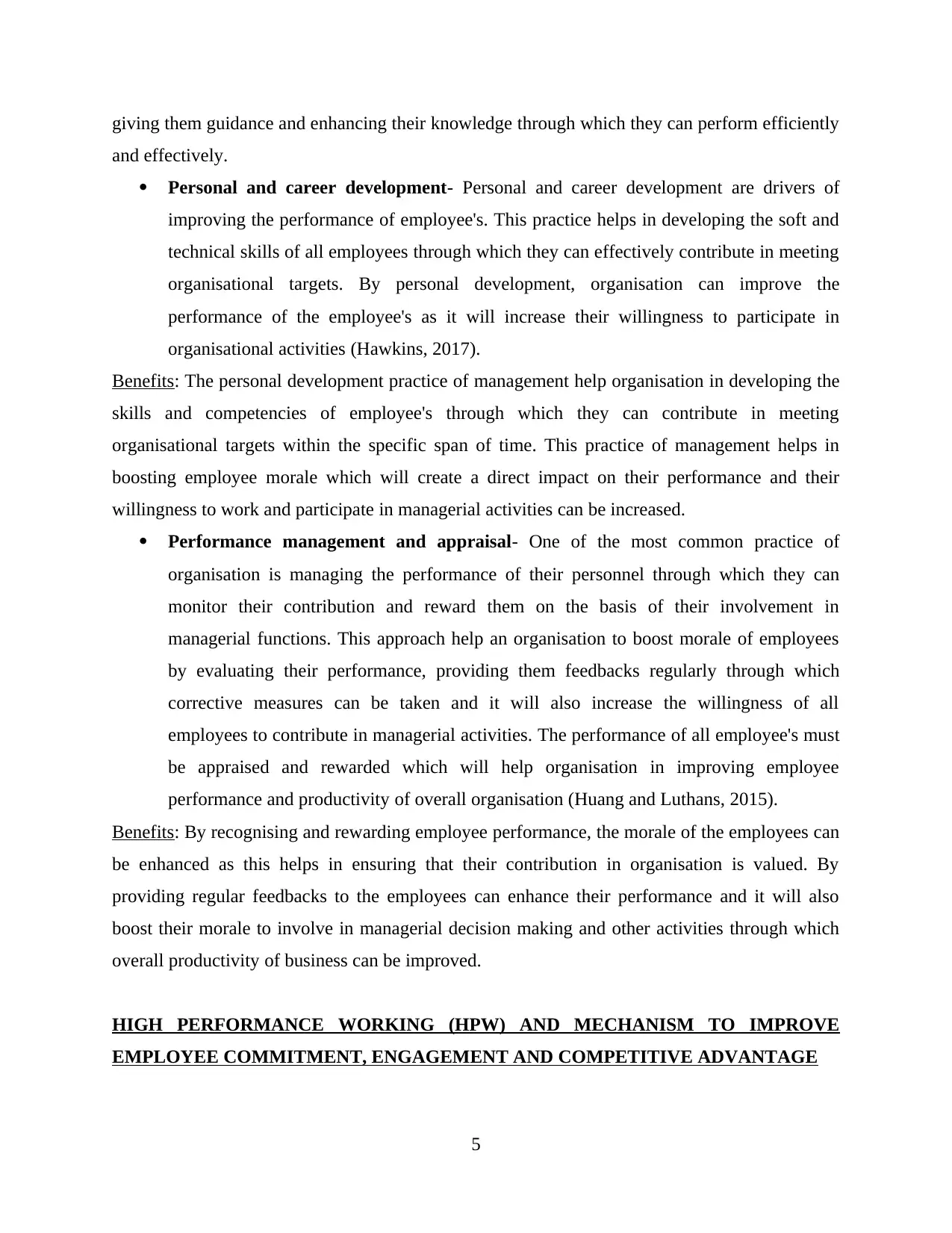
giving them guidance and enhancing their knowledge through which they can perform efficiently
and effectively.
Personal and career development- Personal and career development are drivers of
improving the performance of employee's. This practice helps in developing the soft and
technical skills of all employees through which they can effectively contribute in meeting
organisational targets. By personal development, organisation can improve the
performance of the employee's as it will increase their willingness to participate in
organisational activities (Hawkins, 2017).
Benefits: The personal development practice of management help organisation in developing the
skills and competencies of employee's through which they can contribute in meeting
organisational targets within the specific span of time. This practice of management helps in
boosting employee morale which will create a direct impact on their performance and their
willingness to work and participate in managerial activities can be increased.
Performance management and appraisal- One of the most common practice of
organisation is managing the performance of their personnel through which they can
monitor their contribution and reward them on the basis of their involvement in
managerial functions. This approach help an organisation to boost morale of employees
by evaluating their performance, providing them feedbacks regularly through which
corrective measures can be taken and it will also increase the willingness of all
employees to contribute in managerial activities. The performance of all employee's must
be appraised and rewarded which will help organisation in improving employee
performance and productivity of overall organisation (Huang and Luthans, 2015).
Benefits: By recognising and rewarding employee performance, the morale of the employees can
be enhanced as this helps in ensuring that their contribution in organisation is valued. By
providing regular feedbacks to the employees can enhance their performance and it will also
boost their morale to involve in managerial decision making and other activities through which
overall productivity of business can be improved.
HIGH PERFORMANCE WORKING (HPW) AND MECHANISM TO IMPROVE
EMPLOYEE COMMITMENT, ENGAGEMENT AND COMPETITIVE ADVANTAGE
5
and effectively.
Personal and career development- Personal and career development are drivers of
improving the performance of employee's. This practice helps in developing the soft and
technical skills of all employees through which they can effectively contribute in meeting
organisational targets. By personal development, organisation can improve the
performance of the employee's as it will increase their willingness to participate in
organisational activities (Hawkins, 2017).
Benefits: The personal development practice of management help organisation in developing the
skills and competencies of employee's through which they can contribute in meeting
organisational targets within the specific span of time. This practice of management helps in
boosting employee morale which will create a direct impact on their performance and their
willingness to work and participate in managerial activities can be increased.
Performance management and appraisal- One of the most common practice of
organisation is managing the performance of their personnel through which they can
monitor their contribution and reward them on the basis of their involvement in
managerial functions. This approach help an organisation to boost morale of employees
by evaluating their performance, providing them feedbacks regularly through which
corrective measures can be taken and it will also increase the willingness of all
employees to contribute in managerial activities. The performance of all employee's must
be appraised and rewarded which will help organisation in improving employee
performance and productivity of overall organisation (Huang and Luthans, 2015).
Benefits: By recognising and rewarding employee performance, the morale of the employees can
be enhanced as this helps in ensuring that their contribution in organisation is valued. By
providing regular feedbacks to the employees can enhance their performance and it will also
boost their morale to involve in managerial decision making and other activities through which
overall productivity of business can be improved.
HIGH PERFORMANCE WORKING (HPW) AND MECHANISM TO IMPROVE
EMPLOYEE COMMITMENT, ENGAGEMENT AND COMPETITIVE ADVANTAGE
5
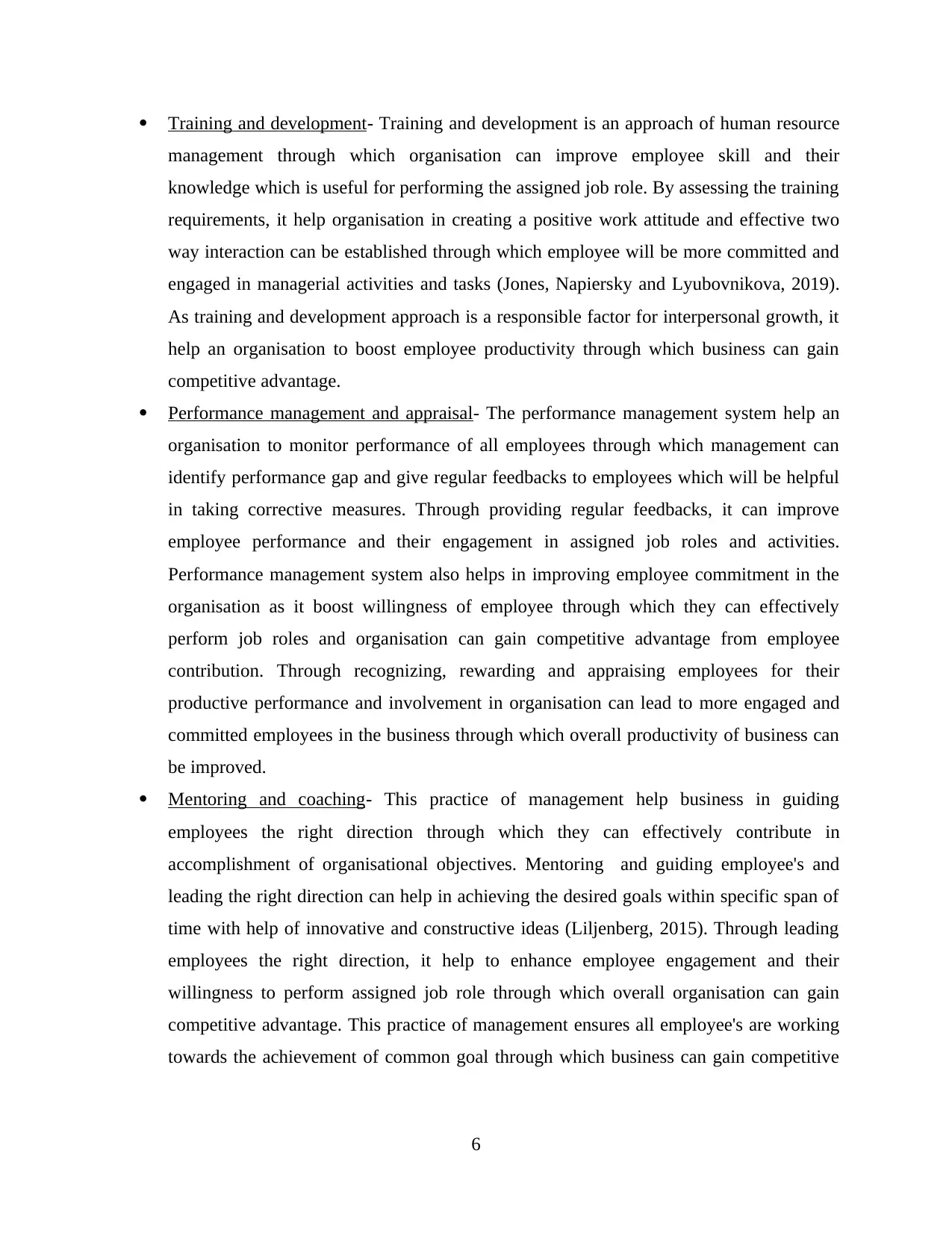
Training and development- Training and development is an approach of human resource
management through which organisation can improve employee skill and their
knowledge which is useful for performing the assigned job role. By assessing the training
requirements, it help organisation in creating a positive work attitude and effective two
way interaction can be established through which employee will be more committed and
engaged in managerial activities and tasks (Jones, Napiersky and Lyubovnikova, 2019).
As training and development approach is a responsible factor for interpersonal growth, it
help an organisation to boost employee productivity through which business can gain
competitive advantage.
Performance management and appraisal- The performance management system help an
organisation to monitor performance of all employees through which management can
identify performance gap and give regular feedbacks to employees which will be helpful
in taking corrective measures. Through providing regular feedbacks, it can improve
employee performance and their engagement in assigned job roles and activities.
Performance management system also helps in improving employee commitment in the
organisation as it boost willingness of employee through which they can effectively
perform job roles and organisation can gain competitive advantage from employee
contribution. Through recognizing, rewarding and appraising employees for their
productive performance and involvement in organisation can lead to more engaged and
committed employees in the business through which overall productivity of business can
be improved.
Mentoring and coaching- This practice of management help business in guiding
employees the right direction through which they can effectively contribute in
accomplishment of organisational objectives. Mentoring and guiding employee's and
leading the right direction can help in achieving the desired goals within specific span of
time with help of innovative and constructive ideas (Liljenberg, 2015). Through leading
employees the right direction, it help to enhance employee engagement and their
willingness to perform assigned job role through which overall organisation can gain
competitive advantage. This practice of management ensures all employee's are working
towards the achievement of common goal through which business can gain competitive
6
management through which organisation can improve employee skill and their
knowledge which is useful for performing the assigned job role. By assessing the training
requirements, it help organisation in creating a positive work attitude and effective two
way interaction can be established through which employee will be more committed and
engaged in managerial activities and tasks (Jones, Napiersky and Lyubovnikova, 2019).
As training and development approach is a responsible factor for interpersonal growth, it
help an organisation to boost employee productivity through which business can gain
competitive advantage.
Performance management and appraisal- The performance management system help an
organisation to monitor performance of all employees through which management can
identify performance gap and give regular feedbacks to employees which will be helpful
in taking corrective measures. Through providing regular feedbacks, it can improve
employee performance and their engagement in assigned job roles and activities.
Performance management system also helps in improving employee commitment in the
organisation as it boost willingness of employee through which they can effectively
perform job roles and organisation can gain competitive advantage from employee
contribution. Through recognizing, rewarding and appraising employees for their
productive performance and involvement in organisation can lead to more engaged and
committed employees in the business through which overall productivity of business can
be improved.
Mentoring and coaching- This practice of management help business in guiding
employees the right direction through which they can effectively contribute in
accomplishment of organisational objectives. Mentoring and guiding employee's and
leading the right direction can help in achieving the desired goals within specific span of
time with help of innovative and constructive ideas (Liljenberg, 2015). Through leading
employees the right direction, it help to enhance employee engagement and their
willingness to perform assigned job role through which overall organisation can gain
competitive advantage. This practice of management ensures all employee's are working
towards the achievement of common goal through which business can gain competitive
6
⊘ This is a preview!⊘
Do you want full access?
Subscribe today to unlock all pages.

Trusted by 1+ million students worldwide
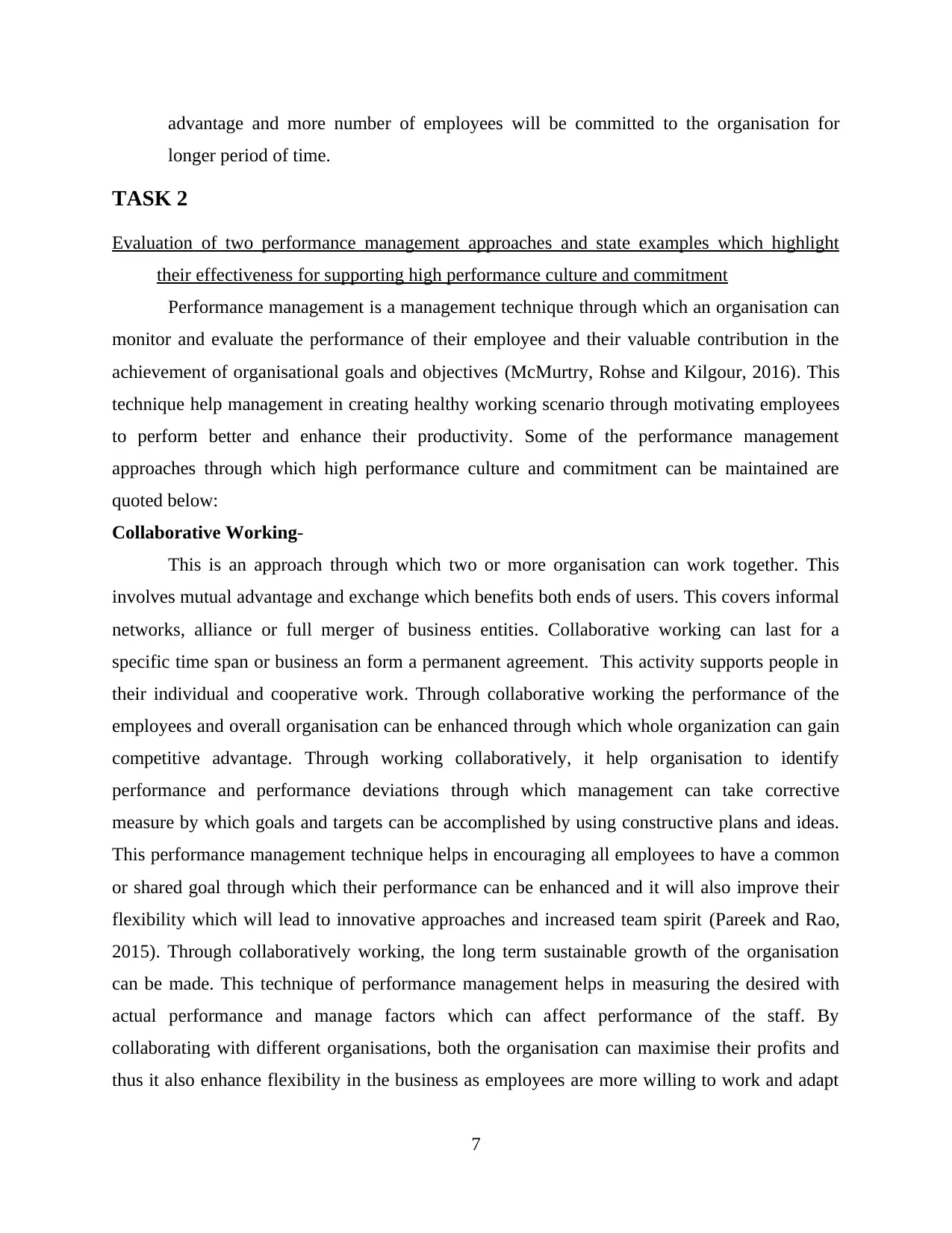
advantage and more number of employees will be committed to the organisation for
longer period of time.
TASK 2
Evaluation of two performance management approaches and state examples which highlight
their effectiveness for supporting high performance culture and commitment
Performance management is a management technique through which an organisation can
monitor and evaluate the performance of their employee and their valuable contribution in the
achievement of organisational goals and objectives (McMurtry, Rohse and Kilgour, 2016). This
technique help management in creating healthy working scenario through motivating employees
to perform better and enhance their productivity. Some of the performance management
approaches through which high performance culture and commitment can be maintained are
quoted below:
Collaborative Working-
This is an approach through which two or more organisation can work together. This
involves mutual advantage and exchange which benefits both ends of users. This covers informal
networks, alliance or full merger of business entities. Collaborative working can last for a
specific time span or business an form a permanent agreement. This activity supports people in
their individual and cooperative work. Through collaborative working the performance of the
employees and overall organisation can be enhanced through which whole organization can gain
competitive advantage. Through working collaboratively, it help organisation to identify
performance and performance deviations through which management can take corrective
measure by which goals and targets can be accomplished by using constructive plans and ideas.
This performance management technique helps in encouraging all employees to have a common
or shared goal through which their performance can be enhanced and it will also improve their
flexibility which will lead to innovative approaches and increased team spirit (Pareek and Rao,
2015). Through collaboratively working, the long term sustainable growth of the organisation
can be made. This technique of performance management helps in measuring the desired with
actual performance and manage factors which can affect performance of the staff. By
collaborating with different organisations, both the organisation can maximise their profits and
thus it also enhance flexibility in the business as employees are more willing to work and adapt
7
longer period of time.
TASK 2
Evaluation of two performance management approaches and state examples which highlight
their effectiveness for supporting high performance culture and commitment
Performance management is a management technique through which an organisation can
monitor and evaluate the performance of their employee and their valuable contribution in the
achievement of organisational goals and objectives (McMurtry, Rohse and Kilgour, 2016). This
technique help management in creating healthy working scenario through motivating employees
to perform better and enhance their productivity. Some of the performance management
approaches through which high performance culture and commitment can be maintained are
quoted below:
Collaborative Working-
This is an approach through which two or more organisation can work together. This
involves mutual advantage and exchange which benefits both ends of users. This covers informal
networks, alliance or full merger of business entities. Collaborative working can last for a
specific time span or business an form a permanent agreement. This activity supports people in
their individual and cooperative work. Through collaborative working the performance of the
employees and overall organisation can be enhanced through which whole organization can gain
competitive advantage. Through working collaboratively, it help organisation to identify
performance and performance deviations through which management can take corrective
measure by which goals and targets can be accomplished by using constructive plans and ideas.
This performance management technique helps in encouraging all employees to have a common
or shared goal through which their performance can be enhanced and it will also improve their
flexibility which will lead to innovative approaches and increased team spirit (Pareek and Rao,
2015). Through collaboratively working, the long term sustainable growth of the organisation
can be made. This technique of performance management helps in measuring the desired with
actual performance and manage factors which can affect performance of the staff. By
collaborating with different organisations, both the organisation can maximise their profits and
thus it also enhance flexibility in the business as employees are more willing to work and adapt
7
Paraphrase This Document
Need a fresh take? Get an instant paraphrase of this document with our AI Paraphraser
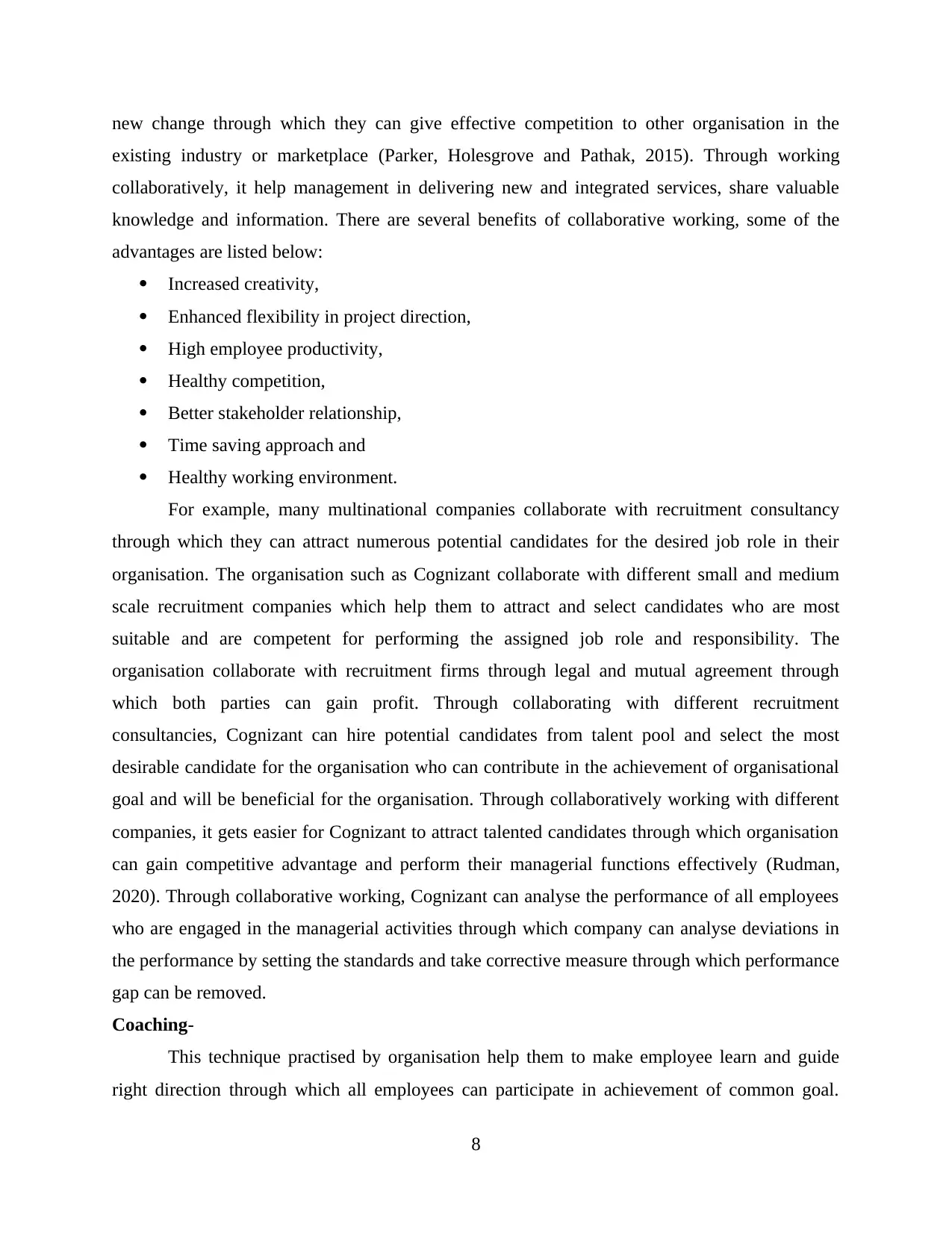
new change through which they can give effective competition to other organisation in the
existing industry or marketplace (Parker, Holesgrove and Pathak, 2015). Through working
collaboratively, it help management in delivering new and integrated services, share valuable
knowledge and information. There are several benefits of collaborative working, some of the
advantages are listed below:
Increased creativity,
Enhanced flexibility in project direction,
High employee productivity,
Healthy competition,
Better stakeholder relationship,
Time saving approach and
Healthy working environment.
For example, many multinational companies collaborate with recruitment consultancy
through which they can attract numerous potential candidates for the desired job role in their
organisation. The organisation such as Cognizant collaborate with different small and medium
scale recruitment companies which help them to attract and select candidates who are most
suitable and are competent for performing the assigned job role and responsibility. The
organisation collaborate with recruitment firms through legal and mutual agreement through
which both parties can gain profit. Through collaborating with different recruitment
consultancies, Cognizant can hire potential candidates from talent pool and select the most
desirable candidate for the organisation who can contribute in the achievement of organisational
goal and will be beneficial for the organisation. Through collaboratively working with different
companies, it gets easier for Cognizant to attract talented candidates through which organisation
can gain competitive advantage and perform their managerial functions effectively (Rudman,
2020). Through collaborative working, Cognizant can analyse the performance of all employees
who are engaged in the managerial activities through which company can analyse deviations in
the performance by setting the standards and take corrective measure through which performance
gap can be removed.
Coaching-
This technique practised by organisation help them to make employee learn and guide
right direction through which all employees can participate in achievement of common goal.
8
existing industry or marketplace (Parker, Holesgrove and Pathak, 2015). Through working
collaboratively, it help management in delivering new and integrated services, share valuable
knowledge and information. There are several benefits of collaborative working, some of the
advantages are listed below:
Increased creativity,
Enhanced flexibility in project direction,
High employee productivity,
Healthy competition,
Better stakeholder relationship,
Time saving approach and
Healthy working environment.
For example, many multinational companies collaborate with recruitment consultancy
through which they can attract numerous potential candidates for the desired job role in their
organisation. The organisation such as Cognizant collaborate with different small and medium
scale recruitment companies which help them to attract and select candidates who are most
suitable and are competent for performing the assigned job role and responsibility. The
organisation collaborate with recruitment firms through legal and mutual agreement through
which both parties can gain profit. Through collaborating with different recruitment
consultancies, Cognizant can hire potential candidates from talent pool and select the most
desirable candidate for the organisation who can contribute in the achievement of organisational
goal and will be beneficial for the organisation. Through collaboratively working with different
companies, it gets easier for Cognizant to attract talented candidates through which organisation
can gain competitive advantage and perform their managerial functions effectively (Rudman,
2020). Through collaborative working, Cognizant can analyse the performance of all employees
who are engaged in the managerial activities through which company can analyse deviations in
the performance by setting the standards and take corrective measure through which performance
gap can be removed.
Coaching-
This technique practised by organisation help them to make employee learn and guide
right direction through which all employees can participate in achievement of common goal.
8
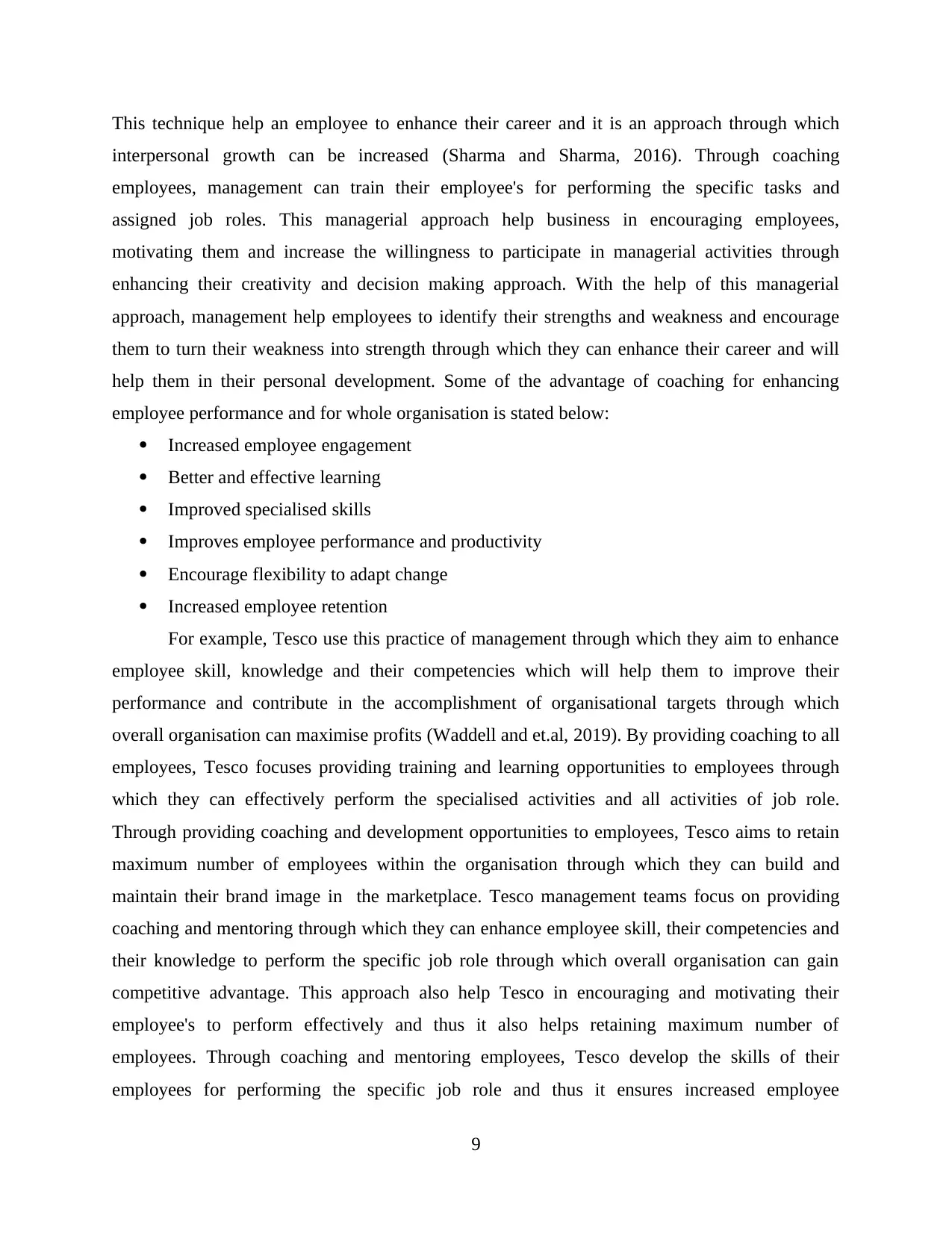
This technique help an employee to enhance their career and it is an approach through which
interpersonal growth can be increased (Sharma and Sharma, 2016). Through coaching
employees, management can train their employee's for performing the specific tasks and
assigned job roles. This managerial approach help business in encouraging employees,
motivating them and increase the willingness to participate in managerial activities through
enhancing their creativity and decision making approach. With the help of this managerial
approach, management help employees to identify their strengths and weakness and encourage
them to turn their weakness into strength through which they can enhance their career and will
help them in their personal development. Some of the advantage of coaching for enhancing
employee performance and for whole organisation is stated below:
Increased employee engagement
Better and effective learning
Improved specialised skills
Improves employee performance and productivity
Encourage flexibility to adapt change
Increased employee retention
For example, Tesco use this practice of management through which they aim to enhance
employee skill, knowledge and their competencies which will help them to improve their
performance and contribute in the accomplishment of organisational targets through which
overall organisation can maximise profits (Waddell and et.al, 2019). By providing coaching to all
employees, Tesco focuses providing training and learning opportunities to employees through
which they can effectively perform the specialised activities and all activities of job role.
Through providing coaching and development opportunities to employees, Tesco aims to retain
maximum number of employees within the organisation through which they can build and
maintain their brand image in the marketplace. Tesco management teams focus on providing
coaching and mentoring through which they can enhance employee skill, their competencies and
their knowledge to perform the specific job role through which overall organisation can gain
competitive advantage. This approach also help Tesco in encouraging and motivating their
employee's to perform effectively and thus it also helps retaining maximum number of
employees. Through coaching and mentoring employees, Tesco develop the skills of their
employees for performing the specific job role and thus it ensures increased employee
9
interpersonal growth can be increased (Sharma and Sharma, 2016). Through coaching
employees, management can train their employee's for performing the specific tasks and
assigned job roles. This managerial approach help business in encouraging employees,
motivating them and increase the willingness to participate in managerial activities through
enhancing their creativity and decision making approach. With the help of this managerial
approach, management help employees to identify their strengths and weakness and encourage
them to turn their weakness into strength through which they can enhance their career and will
help them in their personal development. Some of the advantage of coaching for enhancing
employee performance and for whole organisation is stated below:
Increased employee engagement
Better and effective learning
Improved specialised skills
Improves employee performance and productivity
Encourage flexibility to adapt change
Increased employee retention
For example, Tesco use this practice of management through which they aim to enhance
employee skill, knowledge and their competencies which will help them to improve their
performance and contribute in the accomplishment of organisational targets through which
overall organisation can maximise profits (Waddell and et.al, 2019). By providing coaching to all
employees, Tesco focuses providing training and learning opportunities to employees through
which they can effectively perform the specialised activities and all activities of job role.
Through providing coaching and development opportunities to employees, Tesco aims to retain
maximum number of employees within the organisation through which they can build and
maintain their brand image in the marketplace. Tesco management teams focus on providing
coaching and mentoring through which they can enhance employee skill, their competencies and
their knowledge to perform the specific job role through which overall organisation can gain
competitive advantage. This approach also help Tesco in encouraging and motivating their
employee's to perform effectively and thus it also helps retaining maximum number of
employees. Through coaching and mentoring employees, Tesco develop the skills of their
employees for performing the specific job role and thus it ensures increased employee
9
⊘ This is a preview!⊘
Do you want full access?
Subscribe today to unlock all pages.

Trusted by 1+ million students worldwide
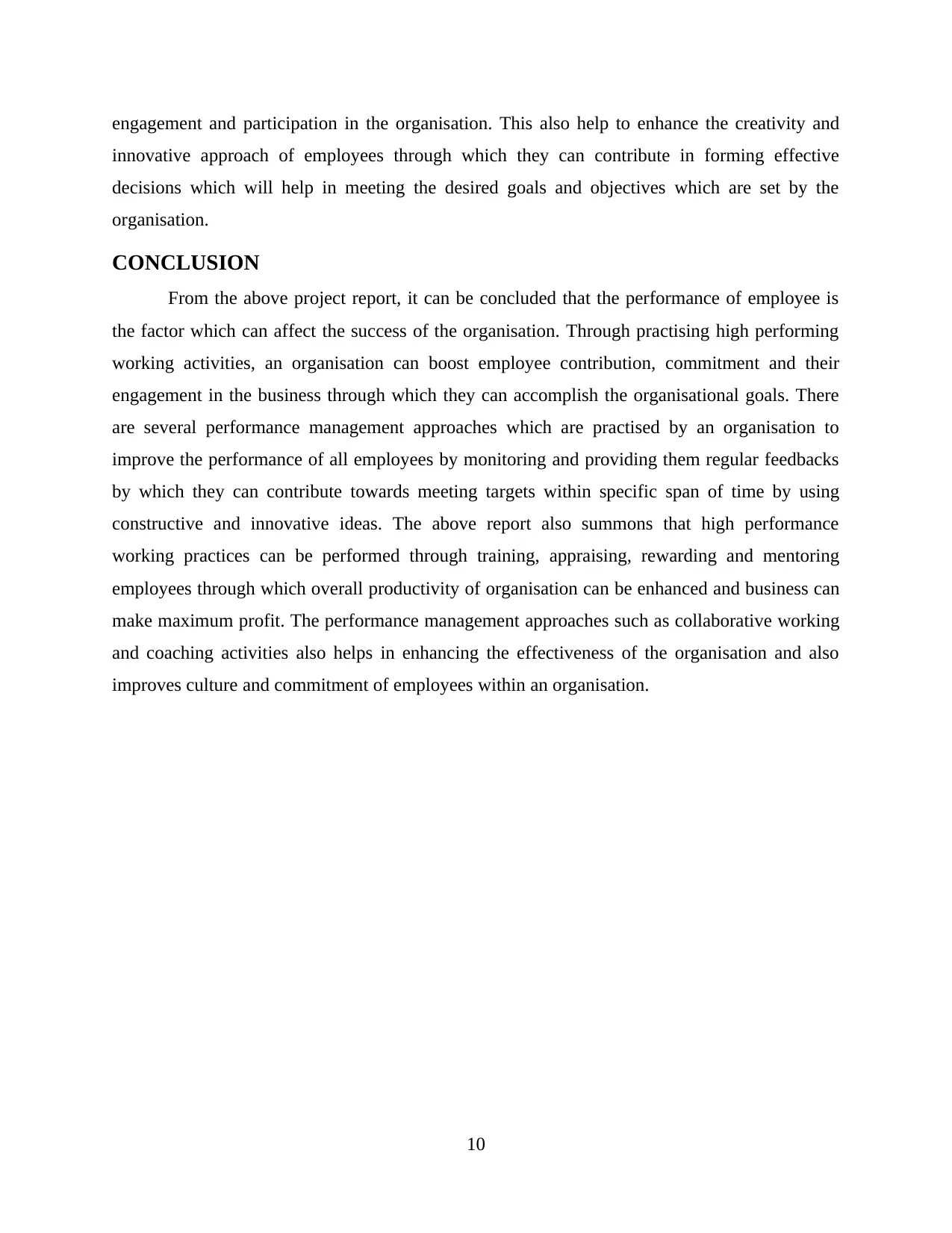
engagement and participation in the organisation. This also help to enhance the creativity and
innovative approach of employees through which they can contribute in forming effective
decisions which will help in meeting the desired goals and objectives which are set by the
organisation.
CONCLUSION
From the above project report, it can be concluded that the performance of employee is
the factor which can affect the success of the organisation. Through practising high performing
working activities, an organisation can boost employee contribution, commitment and their
engagement in the business through which they can accomplish the organisational goals. There
are several performance management approaches which are practised by an organisation to
improve the performance of all employees by monitoring and providing them regular feedbacks
by which they can contribute towards meeting targets within specific span of time by using
constructive and innovative ideas. The above report also summons that high performance
working practices can be performed through training, appraising, rewarding and mentoring
employees through which overall productivity of organisation can be enhanced and business can
make maximum profit. The performance management approaches such as collaborative working
and coaching activities also helps in enhancing the effectiveness of the organisation and also
improves culture and commitment of employees within an organisation.
10
innovative approach of employees through which they can contribute in forming effective
decisions which will help in meeting the desired goals and objectives which are set by the
organisation.
CONCLUSION
From the above project report, it can be concluded that the performance of employee is
the factor which can affect the success of the organisation. Through practising high performing
working activities, an organisation can boost employee contribution, commitment and their
engagement in the business through which they can accomplish the organisational goals. There
are several performance management approaches which are practised by an organisation to
improve the performance of all employees by monitoring and providing them regular feedbacks
by which they can contribute towards meeting targets within specific span of time by using
constructive and innovative ideas. The above report also summons that high performance
working practices can be performed through training, appraising, rewarding and mentoring
employees through which overall productivity of organisation can be enhanced and business can
make maximum profit. The performance management approaches such as collaborative working
and coaching activities also helps in enhancing the effectiveness of the organisation and also
improves culture and commitment of employees within an organisation.
10
Paraphrase This Document
Need a fresh take? Get an instant paraphrase of this document with our AI Paraphraser
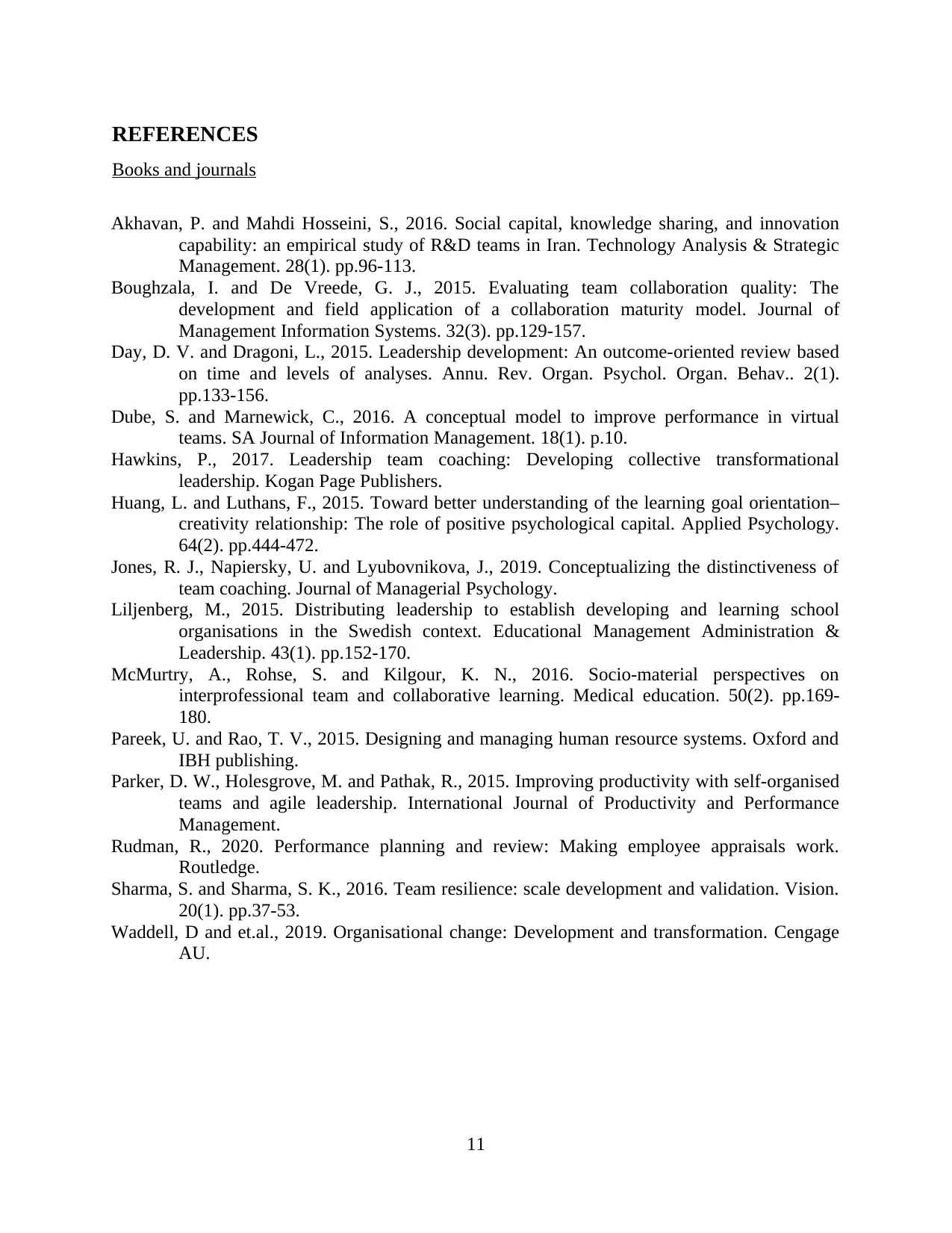
REFERENCES
Books and journals
Akhavan, P. and Mahdi Hosseini, S., 2016. Social capital, knowledge sharing, and innovation
capability: an empirical study of R&D teams in Iran. Technology Analysis & Strategic
Management. 28(1). pp.96-113.
Boughzala, I. and De Vreede, G. J., 2015. Evaluating team collaboration quality: The
development and field application of a collaboration maturity model. Journal of
Management Information Systems. 32(3). pp.129-157.
Day, D. V. and Dragoni, L., 2015. Leadership development: An outcome-oriented review based
on time and levels of analyses. Annu. Rev. Organ. Psychol. Organ. Behav.. 2(1).
pp.133-156.
Dube, S. and Marnewick, C., 2016. A conceptual model to improve performance in virtual
teams. SA Journal of Information Management. 18(1). p.10.
Hawkins, P., 2017. Leadership team coaching: Developing collective transformational
leadership. Kogan Page Publishers.
Huang, L. and Luthans, F., 2015. Toward better understanding of the learning goal orientation–
creativity relationship: The role of positive psychological capital. Applied Psychology.
64(2). pp.444-472.
Jones, R. J., Napiersky, U. and Lyubovnikova, J., 2019. Conceptualizing the distinctiveness of
team coaching. Journal of Managerial Psychology.
Liljenberg, M., 2015. Distributing leadership to establish developing and learning school
organisations in the Swedish context. Educational Management Administration &
Leadership. 43(1). pp.152-170.
McMurtry, A., Rohse, S. and Kilgour, K. N., 2016. Socio‐material perspectives on
interprofessional team and collaborative learning. Medical education. 50(2). pp.169-
180.
Pareek, U. and Rao, T. V., 2015. Designing and managing human resource systems. Oxford and
IBH publishing.
Parker, D. W., Holesgrove, M. and Pathak, R., 2015. Improving productivity with self-organised
teams and agile leadership. International Journal of Productivity and Performance
Management.
Rudman, R., 2020. Performance planning and review: Making employee appraisals work.
Routledge.
Sharma, S. and Sharma, S. K., 2016. Team resilience: scale development and validation. Vision.
20(1). pp.37-53.
Waddell, D and et.al., 2019. Organisational change: Development and transformation. Cengage
AU.
11
Books and journals
Akhavan, P. and Mahdi Hosseini, S., 2016. Social capital, knowledge sharing, and innovation
capability: an empirical study of R&D teams in Iran. Technology Analysis & Strategic
Management. 28(1). pp.96-113.
Boughzala, I. and De Vreede, G. J., 2015. Evaluating team collaboration quality: The
development and field application of a collaboration maturity model. Journal of
Management Information Systems. 32(3). pp.129-157.
Day, D. V. and Dragoni, L., 2015. Leadership development: An outcome-oriented review based
on time and levels of analyses. Annu. Rev. Organ. Psychol. Organ. Behav.. 2(1).
pp.133-156.
Dube, S. and Marnewick, C., 2016. A conceptual model to improve performance in virtual
teams. SA Journal of Information Management. 18(1). p.10.
Hawkins, P., 2017. Leadership team coaching: Developing collective transformational
leadership. Kogan Page Publishers.
Huang, L. and Luthans, F., 2015. Toward better understanding of the learning goal orientation–
creativity relationship: The role of positive psychological capital. Applied Psychology.
64(2). pp.444-472.
Jones, R. J., Napiersky, U. and Lyubovnikova, J., 2019. Conceptualizing the distinctiveness of
team coaching. Journal of Managerial Psychology.
Liljenberg, M., 2015. Distributing leadership to establish developing and learning school
organisations in the Swedish context. Educational Management Administration &
Leadership. 43(1). pp.152-170.
McMurtry, A., Rohse, S. and Kilgour, K. N., 2016. Socio‐material perspectives on
interprofessional team and collaborative learning. Medical education. 50(2). pp.169-
180.
Pareek, U. and Rao, T. V., 2015. Designing and managing human resource systems. Oxford and
IBH publishing.
Parker, D. W., Holesgrove, M. and Pathak, R., 2015. Improving productivity with self-organised
teams and agile leadership. International Journal of Productivity and Performance
Management.
Rudman, R., 2020. Performance planning and review: Making employee appraisals work.
Routledge.
Sharma, S. and Sharma, S. K., 2016. Team resilience: scale development and validation. Vision.
20(1). pp.37-53.
Waddell, D and et.al., 2019. Organisational change: Development and transformation. Cengage
AU.
11
1 out of 11
Related Documents
Your All-in-One AI-Powered Toolkit for Academic Success.
+13062052269
info@desklib.com
Available 24*7 on WhatsApp / Email
![[object Object]](/_next/static/media/star-bottom.7253800d.svg)
Unlock your academic potential
Copyright © 2020–2025 A2Z Services. All Rights Reserved. Developed and managed by ZUCOL.



